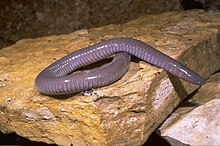Caecilians
| Caecilians Temporal range: Late Cretaceous – Present,100–0 Ma |
|
|---|---|
 |
|
| Dermophis mexicanus | |
| Scientific classification | |
| Kingdom: | Animalia |
| Phylum: | Chordata |
| Class: | Amphibia |
| Clade: | Gymnophiona |
| Order: |
Apoda Oppel, 1811 |
| Families | |
|
Caeciliidae |
|
 |
|
| Current distribution of caecilians (in green) | |
Caeciliidae
Chikilidae
Dermophiidae
Herpelidae
Ichthyophiidae
Indotyphlidae
Rhinatrematidae
Scolecomorphidae
Siphonopidae
Typhlonectidae
Caecilians (New Latin, blind ones) are a group of limbless, serpentine amphibians. They mostly live hidden in the ground, making them the least familiar order of amphibians. All modern caecilians and their closest fossil relatives are grouped as a clade, Apoda, within the larger group Gymnophiona, which also includes more primitive extinct caecilian-like amphibians. Caecilians are mostly distributed in the tropics of South and Central America, Africa, and southern Asia. The diets consists of earthworms and small Subterranean creatures.
Caecilians completely lack limbs, making the smaller species resemble worms, while the larger species, with lengths up to 1.5 m (4 ft 11 in), resemble snakes. Their tails are short or absent, and their cloacae are near the ends of their bodies.
Their skin is smooth and usually dark, but some species have colorful skins. Inside the skin are calcite scales. Because of these scales, the caecilians were once thought to be related to the fossil Stegocephalia, but they are now believed to be a secondary development, and the two groups are most likely unrelated. The skin also has numerous ring-shaped folds, or annuli, that partially encircle the body, giving them a segmented appearance. Like some other living amphibians, the skin contains glands that secrete a toxin to deter predators. The skin secretions of Siphonops paulensis have been shown to have hemolytic properties.
...
Wikipedia
